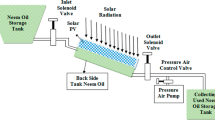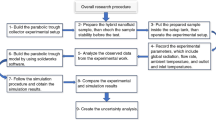Abstract
In this study, performance of a 250 Wp (watt peak) polycrystalline solar cell module was tested by controlling the module temperature with 50 mm thickness Rubitherm RT42 phase change material (PCM) attached at the back of the solar cell module. Solar energy absorbed by the module as heat was transferred to the PCM which was melted when the temperature was higher than its melting point thus the module temperature was reduced and the generated power was increased than that from the normal unit. The enthalpy method was also used to estimate the PCM and the solar cell module temperatures. The generated electrical power from the solar cell module could be evaluated with the module temperature, the solar radiation incidence on the solar cell module and the ambient temperature. It could be found that the simulated results agreed quite well with the experimental data. Under the weather data of Chiang Mai, Thailand for the unit with the PCM, the maximum solar cell module temperature could be decreased from around 73 °C to be 64 °C and the annual average generated electrical energy could be increased 4.3 % compared to that without the PCM.
Similar content being viewed by others
References
Downloads, BP Global, www.bp.com.
REN21, Renewables Global Status Report - REN21 (2018).
J. L. Sawin et al., Global Status Report - REN21, Paris (2016).
E. Skoplaki and J. A. Palyvos, On the temperature dependence of photovoltaic module electrical performance: A review of efficiency/power correlations, Sol. Energy, 83 (5) (2009) 614–624.
M. J. Huang, P. C. Eames and B. Norton, Thermal regulation of building-integrated photovoltaics using phase change materials, Int. J. Heat Mass Transf., 47 (12) (2004) 2715–2733.
M. J. Huang, P. C. Eames and B. Norton, Phase change materials for limiting temperature rise in building integrated photovoltaics, Sol. Energy, 80 (9) (2006) 1121–1130.
J. K. Kaldellis, M. Kapsali and K. A. Kavadias, Temperature and wind speed impact on the efficiency of PV installations. Experience obtained from outdoor measurements in Greece, Renew. Energy, 66 (2014) 612–624.
H. G. Teo, P. S. Lee and M. N. A. Hawlader, An active cooling system for photovoltaic modules, Appl. Energy, 90 (1) (2012) 309–315.
A. S. Kaiser et al., Experimental study of cooling BIPV modules by forced convection in the air channel, Appl. Energy, 135 (2014) 88–97.
H. A. Zondag, Flat-plate PV-Thermal collectors and systems: A review, Renew. Sustain. Energy Rev., 12 (4) (2008) 891–959.
F. Sarhaddi et al., Exergetic performance assessment of a solar photovoltaic thermal (PV/T) air collector, Energy Build., 42 (11) (2010) 2184–2199.
P. H. Biwole, P. Eclache and F. Kuznik, Phase-change materials to improve solar panel's performance, Energy Build., 62 (2013) 59–67.
V. Sun et al., Study on phase change material and its appropriate thickness for controlling solar cell module temperature, Int. J. Ambient Energy (2018) 1–10.
G. M. Masters, Renewable and Efficient Electric Power Systems, John Wiley & Sons, Inc., Hoboken, NJ, USA (2004).
C. Kong, Z. Xu and Q. Yao, Outdoor performance of a lowconcentrated photovoltaic-thermal hybrid system with crystalline silicon solar cells, Appl. Energy, 112 (2013) 618–625.
L. S. Pantic et al., The assessment of different models to predict solar module temperature, output power and efficiency for Nis, Serbia, Energy, 109 (2016) 38–48.
M. C. Alonso García and J. L. Balenzategui, Estimation of photovoltaic module yearly temperature and performance based on nominal operation cell temperature calculations, Renewable Energy, 29 (12) (2004) 1997–2000.
M. Mattei et al., Calculation of the polycrystalline PV module temperature using a simple method of energy balance, Renewable Energy, 31 (4) (2006) 553–567.
RUBITHERM, PCM RT-LINE, Wide-ranging Organic PCM for Your Application, www.rubitherm.eu (2013).
P. Charvát, L. Klimeš and M. Ostrý, Numerical and experimental investigation of a PCM-based thermal storage unit for solar air systems, Energy Build., 68 (2014) 488–497.
S. Armstrong and W. G. Hurley, A thermal model for photovoltaic panels under varying atmospheric conditions, Appl. Therm. Eng., 30 (11) (2010) 1488–1495.
W. S. Janna, Engineering Heat Transfer, CRC Press (2009).
M. K. Fuentes, A Simplified Thermal Model for Flat-Plate Photovoltaic Arrays, Albuquerque, NM (USA) (1987).
G. Notton et al., Modelling of a double-glass photovoltaic module using finite differences, Appl. Therm. Eng., 25 (17) (2005) 2854–2877.
A. I. Kudish et al., Simulation study of a solar collector with a selectively coated polymeric double walled absorber plate, Energy Convers. Manag., 43 (5) (2002) 651–671.
K. Kant et al., Thermal response of poly-crystalline silicon photovoltaic panels: Numerical simulation and experimental study, Sol. Energy, 134 (2016) 147–155.
D. L. Evans and L. W. Florschuetz, Cost studies on terrestrial photovoltaic power systems with sunlight concentration, Sol. Energy, 19 (3) (1977) 255–262.
Acknowledgments
The authors would like to acknowledge to the Research Center for Renewable Energy, Chiang Mai University and the Energy Management of Solar Cell Module with Battery for Air Conditioner in Building under the Development of Alternative Energy Prototypes for Green Communities Project, the National Research Council of Thailand, and Department of Mechanical Engineering, Faculty of Engineering, Chiang Mai University for conducting the experiments facilities and the financial support.
Author information
Authors and Affiliations
Corresponding author
Additional information
Recommended by Editor Yong Tae Kang
Vat Sun is a student in the Energy Engineering Program at Chiang Mai University (CMU). His fields of interest are: Solar cell performance enhancement, Numerical calculation in engineering systems and green biofuel production.
Attakorn Asanakham is an Assistant Professor of the Department of Mechanical Engineering, Faculty of Engineering, Chiang Mai University, Chiang Mai, Thailand. He received his doctoral degree in Energy Engineering from Chiang Mai University. His research interests include energy management, energy efficiency improvement, heat transfer and small particle capture.
Thoranis Deethayat received his Ph.D. from Chiang Mai University, Thailand. He is now working at Chiang Mai University as an Assistant Professor and his research interest is in organic Rankine cycle, biofuels and bioenergy from biomass resources and renewable energy for power cycle.
Tanongkiat Kiatsiriroat achieved his D.Eng. in Energy Technology at Asian Institute of Techology, Thailand in 1987. He is a Professor in Faculty of Engineering, Chiang Mai University. He has a wide range of experiences in heat recovery systems, heat transfer enhancement, thermal energy storage, solar thermal processes and power generation from biomass/solar energy.
Rights and permissions
About this article
Cite this article
Sun, V., Asanakham, A., Deethayat, T. et al. Increase of power generation from solar cell module by controlling its module temperature with phase change material. J Mech Sci Technol 34, 2609–2618 (2020). https://doi.org/10.1007/s12206-020-0336-8
Received:
Revised:
Accepted:
Published:
Issue Date:
DOI: https://doi.org/10.1007/s12206-020-0336-8




